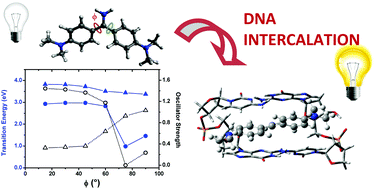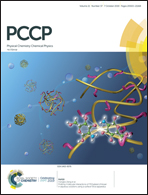Auramine O interaction with DNA: a combined spectroscopic and TD-DFT analysis†
Abstract
In this work, the interaction between an Auramine O (AuO) fluorescent molecular rotor and natural DNA, its thermodynamic aspects and the resulting variation of the optical properties upon binding are addressed by a combined spectroscopic (UV-vis and fluorescence) and computational approach. DNA binding causes a shift in the maximum of absorption from 432 nm to 444 nm, a decrease of the extinction coefficient and a dramatic enhancement of fluorescence emission, these results being in agreement with intercalation into the polynucleotide helix. Intercalation is indeed confirmed by the thermodynamic parameters for the binding reaction (in particular, the highly negative ΔH). Theoretical modelling at the TD-DFT level was done on a simplified model system consisting of the AuO molecule intercalated between two DNA base pairs. The evolution of the calculated vertical transitions quantitatively reproduces the experimentally observed hypo- and bathochromic shifts, thus confirming the intercalation hypothesis.

- This article is part of the themed collection: 2019 PCCP HOT Articles


 Please wait while we load your content...
Please wait while we load your content...